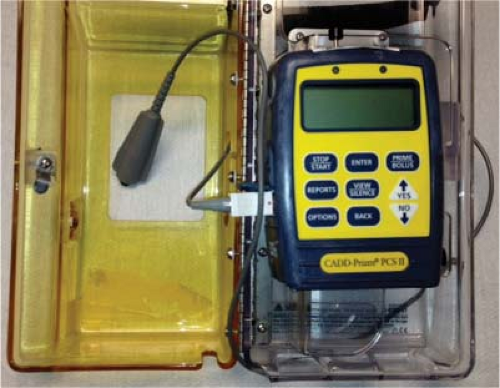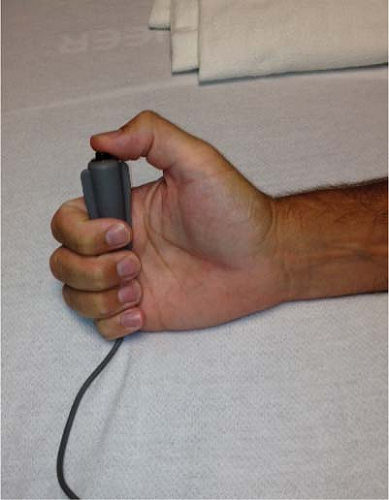Patient-controlled Analgesia
Patient-controlled analgesia (PCA) was first used in 1971. PCA is a way of delivering pain medication via a programmable (IV) infusion device (Fig. 16-1). The PCA machine which is set up at the patient’s bedside and connected directly via tubing to the IV line contains a bag of premixed opioid solution. The patient can self-administer small, physician-determined doses of analgesic medication on demand, referred to as demand dose, by pushing a button connected to the PCA machine (Fig. 16-2). The machine will then lock for a predetermined amount of time before it can administer another demand dose (referred to as the lock-out period), to protect the patient from overmedicating. It is also possible to program the machine to release the drug at a low-dose continuous infusion rate.
The advantages to using a PCA device are many: It is a painless route of delivering opioid medication, it provides prompt analgesia, decreases the burden on the nursing staff, gives patients an enhanced sense of control, and reduces fluctuations in medication level when
compared to intermittent bolus administration. Comparing IV PCA to intramuscular opioid analgesia ordered every 3 to 4 hours as needed showed a significantly greater analgesia efficacy with PCA.1,2 This is especially true in hospitals where the nursing staff has to cover a large amount of patients and cannot distribute medication as promptly as staff in hospitals whose nursing-to-patient ratio is 1:1.
compared to intermittent bolus administration. Comparing IV PCA to intramuscular opioid analgesia ordered every 3 to 4 hours as needed showed a significantly greater analgesia efficacy with PCA.1,2 This is especially true in hospitals where the nursing staff has to cover a large amount of patients and cannot distribute medication as promptly as staff in hospitals whose nursing-to-patient ratio is 1:1.
When to use
A PCA device is typically used when the patient cannot take pain medication orally. This situation may occur during the pre- or postoperative period when the patient is nil per os (NPO; nothing per mouth). It is also used when a patient has nausea and cannot hold down oral medication. PCA devices are frequently useful in cases of severe pain states such as acute pancreatitis, sickle cell crisis, and burn injuries.
How to use
Choosing the Opioid
Typically, one of three medications is used in a PCA device: Morphine, Dilaudid, or fentanyl. All three opiates activate receptors in the brain and spinal cord that modulate the perception of painful stimuli. These medications are available in standard premixed bags. For the scope of this book, the choice of which medication to use is a matter of personal preference. At equal analgesic doses, no medication is stronger than another or better than another unless the patient has an allergy to one of them. None of these three medications is disease specific—one is not better for orthopedic, pelvic, or other types of pain over the other medications. Renal failure may be the one situation in which the medication choice may make a difference: Fentanyl may be preferable because it has no active metabolites. Fentanyl is not typically kept on the hospital floor making morphine and dilaudid the more commonly used choices.
Choosing the Demand Dose
The next step is choosing the dose that the PCA device will deliver when the demand button is pressed—the demand dose. The starting dose for the three commonly prescribed opioids is listed in Table 16-1. It is necessary to double these starting demand doses for patients on chronic opioids. It is important to remember that the demand dose can be adjusted easily.

Full access? Get Clinical Tree










